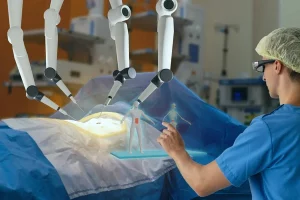One can argue that improved healthcare is the greatest benefit of technology. Even simple equipment like a thermometer greatly affects our lives. Better equipment, remote accessibility, and accurate imaging has helped doctors do a better job. Doctors can use software to maintain the patient’s history and log any new symptoms. Technology has played a role in increasing human life expectancies. Moreover, it has enabled us to create good care practices and improve healthcare standards.
Hospitals and clinics benefit a great deal from technology, but so do regular people. Just in the pandemic, a portable oximeter helped monitor oxygen levels for so many people under quarantine. Technology can help even in our daily lives. For instance, a simple Google search can tell us about the collagen benefits for men. Moreover, mobile apps can help track the menstrual cycle, count calories, and monitor heart rate. Here are a few ways technology is improving healthcare:
Electronic Health Records (EHRs)
EHRs are a complete revolution in the field of medicine. Previously, doctors had to maintain patient records manually. The process was clumsy and left a wide margin for error. Moreover, manual patient records were difficult to log and transfer to other states or hospitals.
EHRs are a massive help as they can connect many systems. Doctors can now share the records with others with ease. They have made it easier for healthcare professionals to provide optimum and integrated care.
Remote Patient Monitoring
RPM or telehealth allows doctors to gather information about their patients outside of healthcare settings. It can bring healthcare out of the hospital and into your home. Technology is making healthcare more accessible for all. Even a person in another country can now consult a doctor in the United States thanks to RPM.
RPM relies on sleek, state-of-the-art devices and information technology to monitor patients. It has also made it to some rural areas where access to healthcare is limited. Moreover, it is useful in emergencies when commuting to a hospital is not an option.
Easily Available Medical Information
Authentic websites like WebMD, MayoClinic, Healthline Media, etc., have made medical information available in the palm of your hands. Most of the time, the factsheets come from healthcare professionals appointed by non-profits. So, you don’t have to run to your doctor every time you get a cold. Sometimes, reliable websites can suggest home remedies to alleviate minor symptoms.
Moreover, it is increasingly common to search for your symptoms online and get anxious. Although these websites provide factual information, they cannot replace a healthcare professional in your life. So, if you don’t understand what you see online or your symptoms are questionable, you should consult your doctor immediately.
Wearable Technology
Wearable technology like smartwatches is getting quite common. They are a great way to monitor vital signs throughout the day. Most smartwatches can monitor heart rate and oxygen saturation. Some of the more advanced ones can even take an ECG.
These wearable health devices can work well to decrease the number of trips to the doctor and mitigate any severe emergencies. They can also help in monitoring an underlying condition and keeping an eye on developing symptoms.
3D Printing
3D printing is fascinating and has made great leaps regarding healthcare. Biomedical engineers can now use a 3D printer to create artificial human organs. Professionals use these for research purposes or transplants. The Integrated Organ and Printing System (ITOP) replicates human tissue using biodegradable plastic and water-based ink.
Professionals have successfully created a human bladder, a non-living kidney, bones, and blood vessels. A lot more can be done with 3D printing when organ printing becomes more mainstream. In the future, ideally, we can print artificial organs for everyone on the organ transplant list.
Mobile Apps for Health Tracking
Mobile apps are also helping to improve healthcare and medicine. Patients can check their test results and even order medicines online. Native health apps in smartphones can track the health of an individual. These apps can track the number of steps you take in a day or count the floors you climbed through stairs. Moreover, it is fairly easy to track the menstrual cycle, log sexual activity, or other symptoms.
You can even make a medical ID on your smartphone in case of emergencies. The paramedics can check your ID to see your blood group, underlying medical conditions, and possible allergies. You can pretty much keep all your medical records on your smartphone.
Robotic Surgery Equipment

Doctors are using machines like the DaVinci Si for complex surgeries in many hospitals in the US. The machine allows the doctors full control of mechanical arms with precise movements. The minute movements can make for an easy and less painful recovery with minor scarring. Moreover, it also reduces the risk of infection as there is no direct human contact. In the future, we might see fully autonomous robots performing major surgeries.
AUTHOR’S BIO:
James Anderson was born in Silver Spring, Maryland. The youngest of five children. He is an experienced creative writer who always pushes the limit and makes the expectation too high in the health niches. He has worked for many health related blogs mainly HSI – healthysupplimentideas.com.
With his 5+ years of experience, He have a great knowledge of health issues which we all can see in his content which is always fresh and updated. He inspires his readers with amazing Health & Fitness Tips as well that actually work in life.








